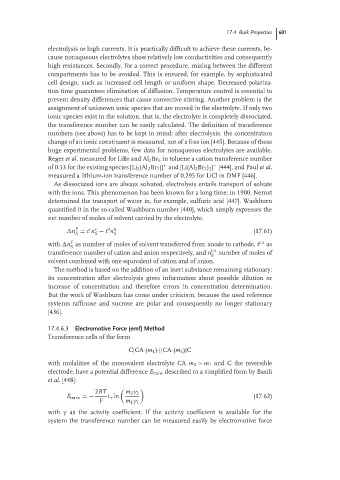Page 627 - Handbook of Battery Materials
P. 627
17.4 Bulk Properties 601
electrolysis or high currents. It is practically difficult to achieve these currents, be-
cause nonaqueous electrolytes show relatively low conductivities and consequently
high resistances. Secondly, for a correct procedure, mixing between the different
compartments has to be avoided. This is ensured, for example, by sophisticated
cell design, such as increased cell length or uniform shape. Decreased polariza-
tion time guarantees elimination of diffusion. Temperature control is essential to
prevent density differences that cause convective stirring. Another problem is the
assignment of unknown ionic species that are moved in the electrolyte. If only two
ionic species exist in the solution, that is, the electrolyte is completely dissociated,
the transference number can be easily calculated. The definition of transference
numbers (see above) has to be kept in mind: after electrolysis, the concentration
change of an ionic constituent is measured, not of a free ion [445]. Because of these
huge experimental problems, few data for nonaqueous electrolytes are available.
Reger et al. measured for LiBr and Al 2 Br 6 in toluene a cation transference number
+
of 0.53 for the existing species [Li 2 (Al 2 Br 7 )] and [Li(Al 2 Br 7 ) 2 ] [444], and Paul et al.
−
measured a lithium-ion transference number of 0.295 for LiCl in DMF [446].
As dissociated ions are always solvated, electrolysis entails transport of solvate
with the ions. This phenomenon has been known for a long time; in 1900, Nernst
determined the transport of water in, for example, sulfuric acid [447]. Washburn
quantified it in the so-called Washburn number [440], which simply expresses the
net number of moles of solvent carried by the electrolyte.
a a
c c
F
n = t n − t n S (17.61)
S
S
F
with n as number of moles of solvent transferred from anode to cathode, t c,a as
S
transference number of cation and anion respectively, and n c,a number of moles of
S
solvent combined with one equivalent of cation and of anion.
The method is based on the addition of an inert substance remaining stationary:
its concentration after electrolysis gives information about possible dilution or
increase of concentration and therefore errors in concentration determination.
But the work of Washburn has come under criticism, because the used reference
systems raffinose and sucrose are polar and consequently no longer stationary
[436].
17.4.6.3 Electromotive Force (emf) Method
Transference cells of the form
C|CA·(m 1 )·||CA·(m 2 )|C
with molalities of the monovalent electrolyte CA m 2 > m 1 and C the reversible
electrode, have a potential difference E trans described in a simplified form by Basili
et al. [448]:
2RT m 2 γ 2
E trans =− t + ln (17.62)
F m 1 γ 1
with γ as the activity coefficient. If the activity coefficient is available for the
system the transference number can be measured easily by electromotive force

